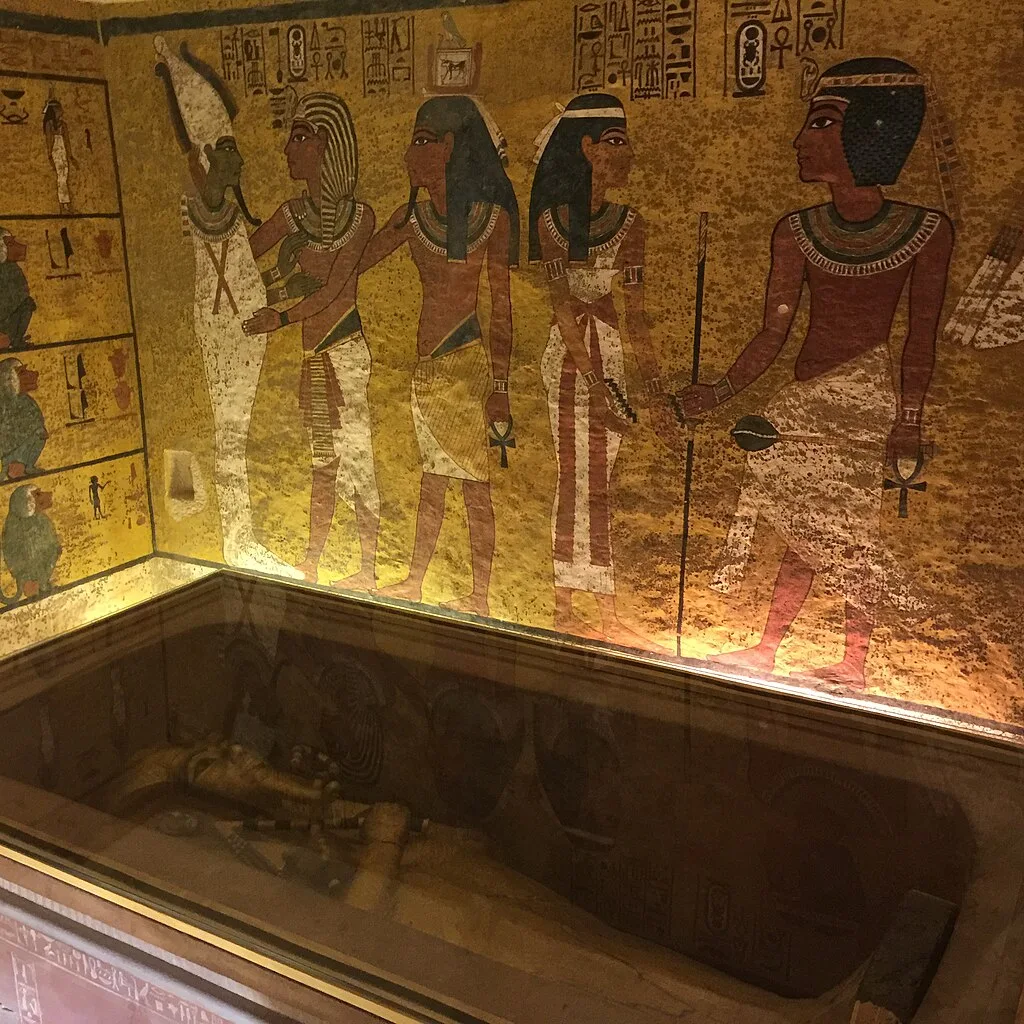On November 4, 1922, a young boy working for a British excavation team led by archaeologist Howard Carter was riding his donkey home when the animal suddenly stumbled into a hole in the sand. This seemingly minor incident led to one of the greatest archaeological discoveries in history—the tomb of King Tutankhamun.
 |
King Tutankhamun middle coffin / Image Credit: Wikimedia |
The site was excavated by Carter along with his fellows, and found a strange chamber deep in the shifting sands. The moment they ferried some light into the room, they saw a splendid spectacle, the magnificent treasure of gold and ebony artifacts. Behind this chamber was another, guarded by two colossal idols, and blocked with complicated knots made with ropes and a clay plug. The tomb of King Tut, long lost to mankind, had been finally discovered.
An Untouched Tomb Full of Treasures
Unlike most previously discovered Egyptian pharaohs’ tombs, King Tut’s tomb was untouched. It had neither been plundered nor destroyed, preserving a stunning array of more than 5,000 relics. This find provided an unparalleled wealth of archaeological data, as well as a magnificent display of ancient Egyptian craftsmanship.
After nearly three months cataloging the artifacts in the tomb’s antechamber, on February 16, 1923, Carter finally broke the seal protecting King Tut’s burial chamber, which had remained undisturbed for over 3,000 years.
 |
| The outer coffin and sarcophagus in Tutankhamun's tombs burial chamber. / Image Credit: Wikimedia |
Inside the burial chamber, Carter discovered that Tutankhamun’s mummy was enclosed within nine protective layers. His sarcophagus was elaborately designed, featuring gold inlays and precious stones. As Carter and his team carefully unwrapped the mummy, they unveiled the face of Tutankhamun—a sight unseen by any living person for nearly 3,500 years.
In Egyptian belief, a person continued to exist as long as their name was remembered. With the discovery of his tomb, King Tutankhamun’s name would never be forgotten, almost as if he had been resurrected through history.
Did the Pharaoh’s Curse Strike?
As Carter and his team basked in their incredible success, a series of mysterious deaths followed, fueling rumors of a pharaoh’s curse.
The first ominous sign appeared when, shortly after the tomb’s discovery, Carter’s pet canary was killed by a king cobra, a serpent symbolic of the Egyptian pharaohs. Some saw this as a warning.
Then came the tragic fate of Lord Carnarvon, the financier of the excavation. While inventorying the tomb’s treasures, he suffered a mosquito bite, which later became infected. A few days after accidentally nicking it with a razor, he developed blood poisoning and died.
A prominent British radiologist who x-rayed King Tut’s mummy also met an untimely end, falling victim to a mysterious, undiagnosed disease that ultimately proved fatal. In total, at least seven members of Carter’s expedition died unexpectedly soon after the tomb was opened.
Must Read:
- The Ancient Egyptian Mummy That Has Never Been Opened
- Ancient Inventions That Prove Our Ancestors Were Geniuses
Was the Curse Real?
While skeptics argue that these deaths were mere coincidences, others believe that by disturbing King Tut’s mummy, the archaeologists had triggered an ancient Egyptian curse. Ancient Egyptians believed that death was not the end, but for a spirit to achieve eternal life, the body had to remain undisturbed. Inscribed warnings on tombs often stated that anyone who violated a burial site would suffer dire consequences.
King Tutankhamun's Mummy First Time Opened for Public
Many who entered ancient Egyptian tombs met bizarre and untimely ends, leading some to question whether the pharaohs’ curses were real or simply eerie coincidences. Regardless, the discovery of King Tutankhamun’s tomb remains one of the most significant in history, unlocking invaluable insights into ancient Egyptian civilization and continuing to captivate the world a century later.
SOURCES: Smithsonian Magazine / Wikipedia / MENTAL FLOSS
